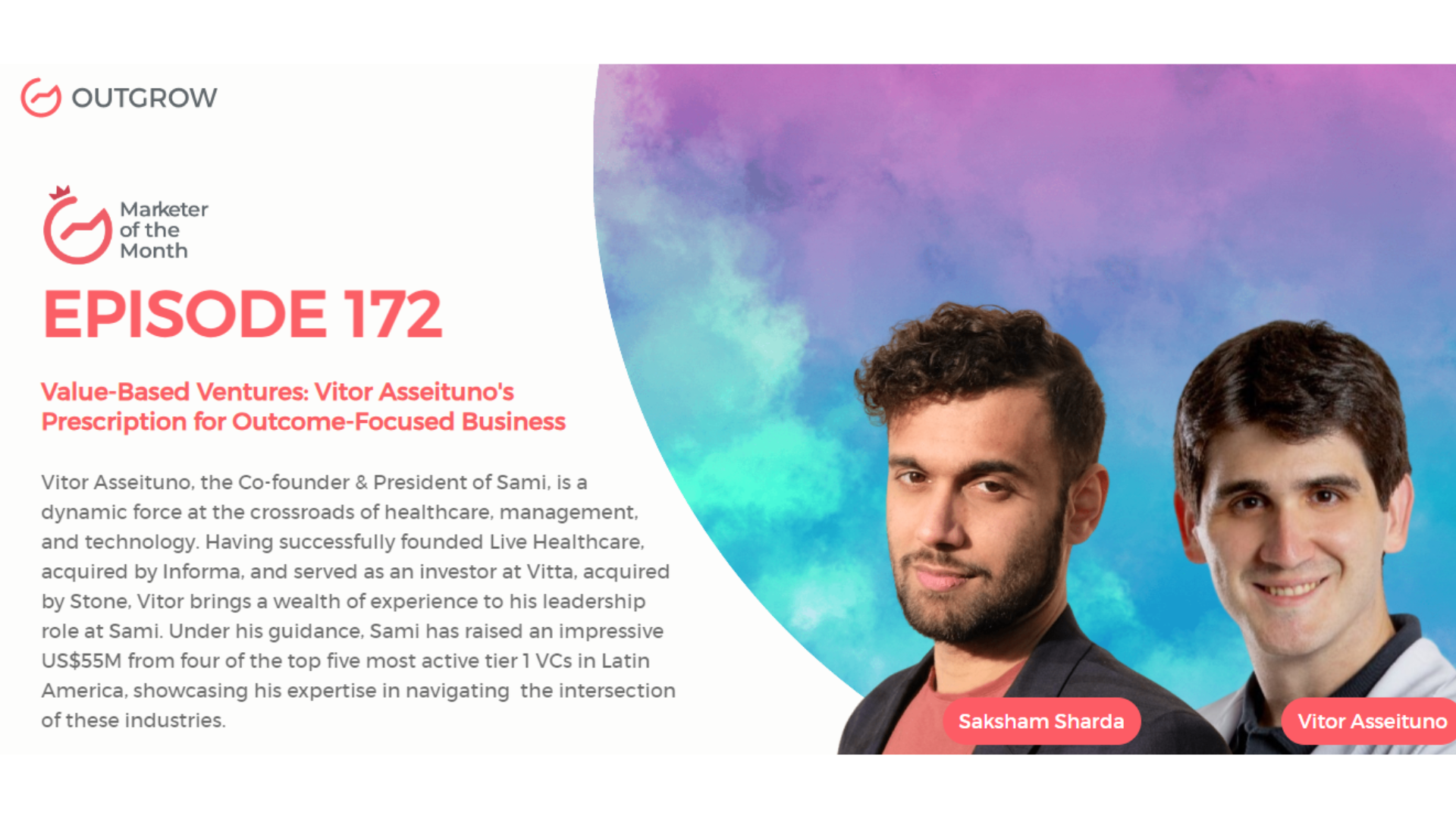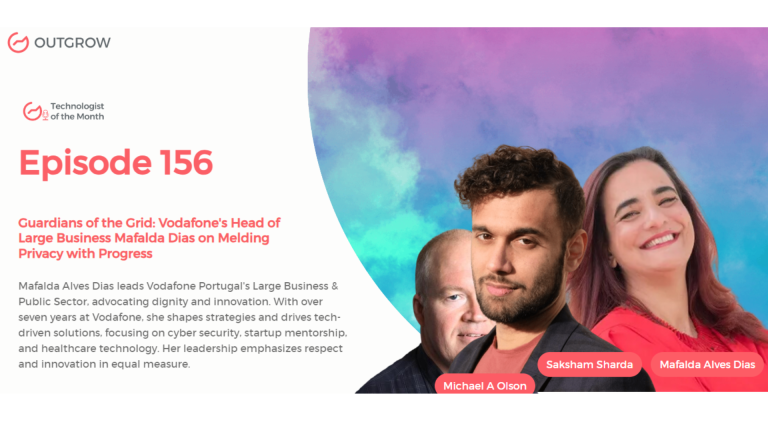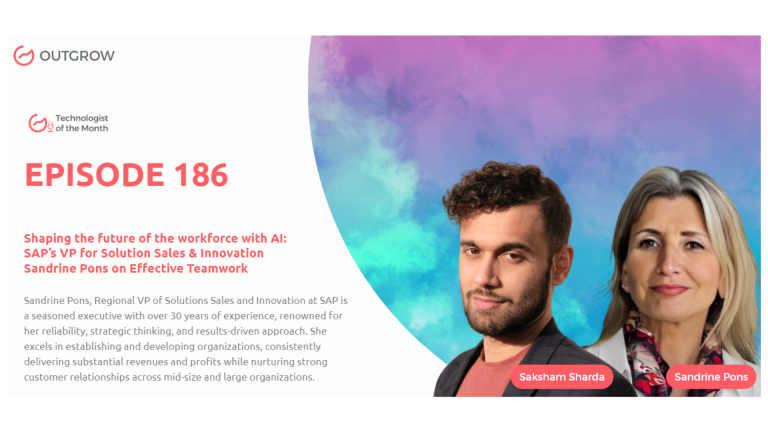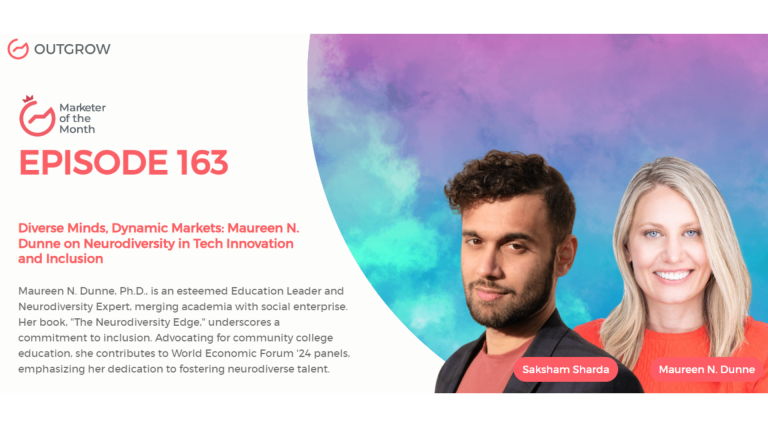Hey there! Welcome to the Marketer Of The Month blog!
We recently interviewed Vitor Asseituno for our monthly podcast – ‘Marketer of the Month’! We had some amazing insightful conversations with Vitor and here’s what we discussed about-
1. Diverse Teams Matter: Acknowledge the challenges of diverse team collaboration.
2. Startup Culture: Emphasizing the importance of a hustler mindset.
3. Smart Marketing Tactics: Waiting lists, referrals, and utilizing unconventional platforms are effective.
4. Post-COVID Healthcare Challenges: Analyze hurdles in the healthcare system.
5. Outcome-Focused Business Model: Value-based care pays for results.
6. Adapt for Faster Improvement: Stress the importance of short measurement cycles.
7. Series A Impact: Address challenges in managing larger capital.
About our host:
Dr. Saksham Sharda is the Chief Information Officer at Outgrow.co. He specializes in data collection, analysis, filtering, and transfer by means of widgets and applets. Interactive, cultural, and trending widgets designed by him have been featured on TrendHunter, Alibaba, ProductHunt, New York Marketing Association, FactoryBerlin, Digimarcon Silicon Valley, and at The European Affiliate Summit.
About our guest:
Vitor Asseituno, the Co-founder & President of Sami, is a dynamic force at the crossroads of healthcare, management, and technology. Having successfully founded Live Healthcare, acquired by Informa, and served as an investor at Vitta, acquired by Stone, Vitor brings a wealth of experience to his leadership role at Sami. Under his guidance, Sami has raised an impressive US$55M from four of the top five most active tier 1 VCs in Latin America, showcasing his expertise in navigating the intersection of these industries.
EPISODE 172: Value-Based Ventures: Vitor Asseituno’s Prescription for Outcome-Focused Business
Table of Contents
The Intro!
Saksham Sharda: Hi, everyone. Welcome to another episode of Outgrow’s Marketer of the Month. I’m your host, Dr. Saksham Sharda, and I’m the creative director at Outgrow. co. And for this month we are going to interview Vitor Asseituno, who is the Co-founder and President at Sami.
Vitor Asseituno: Great to be here. Thank you.
Don’t have time to read? No problem, just watch the Podcast!
Or you can just listen to it on Spotify!
The Rapid Fire Round!

Saksham Sharda: So, Vitor, we are going to start with a rapid-fire round. Just to break the ice, you get three passes. In case you don’t want to answer the question, you can just say pass. But try to keep your answers to one word or one sentence only.
Vitor Asseituno: Alright.
Saksham Sharda: So the first one is, at what age do you want to retire?
Vitor Asseituno: Soon.
Saksham Sharda: How long does it take you to get ready in the mornings?
Vitor Asseituno: 20 minutes.
Saksham Sharda: Most embarrassing moment of your life.
Vitor Asseituno: Pass.
Saksham Sharda: Favorite color?
Vitor Asseituno: Black.
Saksham Sharda: What time of day are you most inspired?
Vitor Asseituno: 10:00 AM.
Saksham Sharda: How many hours of sleep can you survive on?
Vitor Asseituno: Six.
Saksham Sharda: Fill in the blank. An upcoming marketing trend is _____.
Vitor Asseituno: Generative AI.
Saksham Sharda: The city in which the best kiss of your life happened
Vitor Asseituno: Tomol.
Saksham Sharda: Pick one Mark Zuckerberg or Elon Musk.
Vitor Asseituno: Elon Musk.
Saksham Sharda: The biggest mistake of your career?
Vitor Asseituno: Pass.
Saksham Sharda: How do you relax?
Vitor Asseituno: My kids and wives.
Saksham Sharda: How many cups of coffee do you drink per day?
Vitor Asseituno: Zero. Don’t drink coffee.
Saksham Sharda: A habit of yours that you hate.
Vitor Asseituno: Av.
Saksham Sharda: The most valuable skill you’ve learned in life?
Vitor Asseituno: Hear people.
Saksham Sharda: And the last one is your favorite Netflix show.
Vitor Asseituno: What is the name? This is the one from the Adams family. I don’t remember the name.
Saksham Sharda: Which one do you mean? Wednesday Adams. That’s the show.
Vitor Asseituno: Yeah.
Saksham Sharda: Alright, well, that’s the end of the rapid-fire round. Is there any question you want to elaborate on in more detail?
Vitor Asseituno: No. Just the questions I pass, I would need more time to reflect on them to remember.
The Big Questions!

Saksham Sharda: So now we can move on to the longer questions. There you can answer with as much ease and time as you like. The first one is, how did you identify the opportunities at the intersection of healthcare management and technology?
Vitor Asseituno: Perfect. Healthcare is a key industry for all human beings because healthcare means taking care of our health to be alive and well. So I think it’s a key industry for everyone in the world. I mean, 7 billion people need healthcare. So technology and management. They are tools to make healthcare better, affordable, more efficient, and more pleasant. So I think if something is important, management should be relevant. Management is a good way to do something. And technology, it’s a tool to leverage the management decisions you want to implement. As a key industry, as a key element management technology is very important so we can all live better. So, that’s it.
Saksham Sharda: What are some of the ways in which you’ve managed to make these intersections work well at your company?
Vitor Asseituno: Yeah. I think everyone values the multidisciplinary or interdisciplinary approach to stuff. I mean, bringing different people with different backgrounds in healthcare that would be bringing a physician and a developer and an engineer and a businessman and a hustler, say, well, how can we build things together? What I learned is that it’s very hard. You get like a 60-year-old doctor and an 18-year-old or developer, and you put them together and say, wow, let’s be multidisciplinary, like work together. Usually when those things work better is when people are multi-secondary themselves to some extent. So I’m a physician myself, but I did some coding before medical school. I’m running companies out of medical school, so I’m already at the intersection of management, technology, and healthcare. So we have one of our doctors who came from McKinsey, she did an MBA. We have one guy, who is a lawyer, but he understands healthcare a lot. My co-founder is a businessman who built hospitals and clinics from scratch. So I think it’s easier to be disciplined when you have people that already have a bit of each content inside because these people become the connectors, the translators between the doctors and developers and, and everyone else that you need to. So I think that’s a key element that I learned.
Saksham Sharda: And who’s the hustler in this scenario?
Vitor Asseituno: I think it is a startup. Everyone has to be a hustler. I mean, otherwise, you don’t survive. So, we always try to stimulate hustler behaviors. And my co-founder and I, both have opened companies before bootstrapping the first companies. So, I think that the thing that connected us at the beginning and is still today, is the hustler behavior, the hustler mindset. I mean, being scrappy. We raised a lot of venture capital for the company so far, but also in this winter of venture capital, there is less, less capital available. Capital is more scarce now. We feel at ease in terms of, well, we never operated with capital before. I mean, there was capital, this good. I mean, there’s no capital. We know how to operate in a crappy environment being hustlers ourselves.
Saksham Sharda: So could you share any specific marketing campaigns or initiatives that you implemented and the impact on your company’s growth?
Vitor Asseituno: Perfect. The first thing we did that was huge for the company was a waiting list. The typical waiting list. So we sell health insurance, and what we did was we announced our Series A and we said, well, there is a waiting list. We are gonna launch the product in a few weeks. Here’s the fill the form and have the waiting list for you to, and that was very effective. I don’t remember the specific volume and ranges, but I think we got 300 qualified leads from zero CAC just with PR in the first like two weeks of the company after launch with this waiting list. And from that, we converted our first customers and got awareness. That also was I think a top-risk customer was a good opportunity to find the ICP because we had an idea of the ICP, but we don’t have a waiting list and you have to talk to each of them to understand. There was very good discovery in terms of, oh, who is gonna be our ideal customer profile at the beginning. So that was a first, I think very not soon after that, not too long after that, we started getting members. So we discovered that Member, Gati member was an interesting task. And today 15 to 20% of our acquisition comes from Member Gati members. So like referrals. And, this is something, it’s very unique for a health insurance company. Also TikTok I think we were probably the first health insurer to sell TikTok company plans. I mean enterprise or s and b plans on TikTok. We have one video, TikTok has 20 million views. I was in the US the other day talking through a private equity ambassador and saying, we were selling health insurance on TikTok. I said, I mean, how are you guys selling health insurance on TikTok? And it’s really interesting the results coming from that.
Saksham Sharda: So who was your ideal customer profile back then when you started on the waiting list? And how has it evolved to now?
Vitor Asseituno: The ideal customer profile at the beginning was people without insurance. There were solopreneurs. So people who are like Uber drivers, hairdressers, marketers, designers, and journalists own the LLC because we sell only company plans. We don’t sell individual plans, but that was the first ICP, and most of them were without insurance. So a lot of people were changing from different shirts to Senator Uninsured. They said, well, I see this plan. I have a business entity I can use to purchase the plan for the product, the price is affordable. I wanted to do it, so that was our first ICP. Today we are evolving to bigger and bigger companies. So the first company with 200 employees, the first company, with 700 employees. So now we’re going to bigger companies. It’s still the ICP if the first ICP is very relevant. There are 13 million people like individual entrepreneurs and entrepreneurs with LLCs. But we are also adding bigger companies as well where data economics is good.
Saksham Sharda: So what was your motivation, when you started it all out behind, you know, co-founding Sami, and how your background as a physician influenced your vision of this company?
Vitor Asseituno: Richard? I saw I was an entrepreneur and an investor, and I saw over five, four, or 500 maybe more startups in healthcare. And healthcare is hard. I mean there is the famous death by pilots. I mean, people start pilots and hospitals, large health systems, and they take forever to get results. There are long sale cycles. The market is entrenched by conservative physician associations or big health systems. So, it’s a tough market. And I understood that being a payer, being health insurance that can put money upfront, it was a very interesting place to be. Who pays the piper called the tools, right? So if you were the payer, you could pay people to do this or that. You could pay providers, you could pay partners, you could buy stuff. So I also recover revenue, it’s a very powerful thing in a business. So my previous company didn’t have recurring revenue every year. I mean, I have to reach the revenue of the past year. Again, before growing the company at Semino, we started every year with this million dollars in an RR and, then we can grow from that. So our recurring revenue business is very powerful as well. And also I learned that market size matters when you are an entrepreneur. It’s a key definition of building a large company and building, and health insurance is the biggest thing you can build in health. There is even an article from C Orbit saying the biggest company in the world is the title of the article. And then, the company’s talking about is a health insurance company, or how they call it a pay provider, which is a payer slash provider, a payer that also provides care. So a few of those things helped me just say, well, being the platform, being the mothership of healthcare can be very interesting if you wanna do new innovative stuff. And, as a physician, for me, having the opportunity to correct medical evidence, to produce medical evidence, to offer quality healthcare to people at lower prices, that’s, I mean, what every doctor wants to do. I mean, do good medicine, make it affordable, and, and take care of people in the long run.
Saksham Sharda: And so what is the state of healthcare in Brazil right now? If you had to like, give us a glimpse of that and do you plan on expanding outside?
Vitor Asseituno: Yeah, I think if we were on the far side. To the word, I would say it was overstretched. I think most health systems in the world are in that condition right now, especially after COVID-19. I mean, populations grow, and healthcare costs grow faster. And there’s new technologies, new medicine, new whatever every day. We haven’t been able to change the workforce for AI. So we need good doctors, good nurses. So it’s costly and it’s hard. And it’s disorganized. And I mean, COVID was a very good show to me that, I mean, nobody knew what was happening. I mean, three big trillion people sorry, 3 billion people were at home not working. And nobody knew. I mean, wear a mask. Do not wear a mask. This medication works. This medication doesn’t work. Who is coordinating the agenda? How health systems around, around the globe collaborate? In my opinion, that was a mess. I mean, so I think we need better evidence in healthcare. We need better coordination. We need more technology. We need to help doctors and nurses to be more productive with AI. So there are a lot of needs that we have in healthcare to help people in health systems that are overstretched and need care.
Saksham Sharda: And so how does your company’s value-based healthcare business model benefit both healthcare professionals and patients?
Vitor Asseituno: Yeah, value-based care, it’s a way to do merit in healthcare. I mean, once we are paid per doctor per visit, they are delivering visits. I mean, if you paid me per visit, okay, every system is perfectly designed for things. It provides. So, nobody wants to visit. I mean, we won’t care. We want to have our healthcare problems solved. We want a successful surgery. And even if we don’t need surgery, the better. I mean, if we don’t need to do the surgery, for example, every surgery, every good surgery that wasn’t needed, it’s a bad surgery. So database care is a way to recover the evidence of what they call clinical acne. So what do we need to do here? What doctors are performing and getting the best results, and how can we pay by merit to the hospital providers and physicians who are getting the best results? Because if we pay everyone the same people are not like, incentivize it to be better or to do more. I mean, people are like, well, the insurance pays a hundred bucks for every visit to all the doctors in my town, so I’m going to deliver visits. Not like good visits, not good care, not proactive care, not good surgery. So, the challenge was how to measure what a good visit is, what is when someone needs a visit or surgery, or what good results for surgery. So what I think technologies allow us to do is to do this kind of measurements at the point of care, at scale, and looking at personalizing the protocols and journeys that. And I think one of the best things about technology, it has a killer application, is how to personalize at scale. I mean, if I open my Netflix and you open your Netflix, it’s gonna be different because based on the shows you watch, the shows I watch, but when we go to a hospital, the emergency room is the same. The health system is the same. The doctor’s gonna see me and you are the same. So how can we personalize at scale? Because I have different needs than you have at different moments in time. We might have different needs. I prefer telemedicine. You prefer in person, you live closer to the hospital. I live far from the hospital. I like nursing visits. You don’t like nursing visits. So it’s different for each of us. So I think technology can be very powerful for that.
Saksham Sharda: And how do you ensure in your company the efficiency and quality of the care provided by your healthcare professionals within your network? And how do you measure and incentivize this?
Vitor Asseituno: In every system, you have to start measuring something. I mean, sometimes you’re gonna get wrong. I mean, oh, we got the wrong measurement, the other one’s better. You have to start incentivizing people’s points and see how they react to that. What is the right measurement? 20% of their payments are gonna be a variable or 30% is better. It’s for everyone in the system. I mean, are we gonna do variable pay for nurses and doctors and third-party networks? And what is the ideal cycle of measurement? I mean, we should give them the KPIs every 30 days, every three months, every year. How so? So I think to learn, you have to implement some measurements, some incentives, and some KPIs and, and see how it evolves to the outcomes you have. Also, the outcomes arrived over time. Let’s say at Sami, it sells at the beginning we’re looking at the number of lives. I mean, our sales team was incentivized by the number of lives. Then we said, well, but the number of lives alone, it doesn’t seem like an average ticket. So we changed it to sales teams. Let’s pay for revenue, the amount of revenue we bring in. So we started to pay people based on the revenue data standpoint. Revenue is not margin. We can have a lot of revenue, but no margin. How can we, so now avoid margin? So I think it’s the same thing for doctors and nurses. Oh, they’re doing a lot of visits, but not following your protocols. Well, let’s help them. Let’s give the KPI to adapt to all protocols. Oh, they follow the protocols, but every visit takes an hour and there’s a longer waiting line. So the doctors have to be faster and more efficient. So let’s pay for the number of visits and efficiency and time of the visit and waiting times. And so based on the needs of the population and the system and the outcomes you wanted to achieve you can change the incentives to aim that goal.
Saksham Sharda: And when do you think is the right time or how often to change these measurements of incentives?
Vitor Asseituno: I mean, I think everything should be measured. All the time in sales, for example, we start with monthly goals. There’s a quarter goal, but we break that into monthly goals. Then we went to bi-monthly goals. Now we have daily goals. So today we go, for example, today we are the last time I checked at a hundred percent, 110% of the move to date go. So it’s kind of a daily goal. So today people are doing well. If it’s like midday and we’re not hitting the target, I mean, we should do something in the afternoon to get to the end of the day with the target hit. If we do that 360 days a year, we are gonna hit our yearly goals. So I think the smaller the time of the cycle of measurement also people would learn faster because after you finish a cycle of measurement and you see, well, we didn’t hit the measurement, what can we learn from that? That was a mistake. This thing didn’t work. And then we improved the next cycle. When the cycles are too long, your learning curve is too long. So always try to keep it like shorter learning cycles, and shorter measurement cycles so we can learn, and improve faster. So, but, of course in some KPIs or some metrics, they take more time to develop. But if we can break the go by minute it would be kind of ideal. So it’s like when you’re driving and you’re driving and you have the speed limit and say, well, now I’m driving under the speed limit. Now I can go faster because of the two under the speed limit. So you can speed up. So I think it might be a good analogy in how the feedback you have and how you can adjust, I think driving might be a good example of taking the shorter learning sideways you can have.
Saksham Sharda: And how did the significant series A funding in 2020 impact your driving speed, and your marketing plans, and enable you to expand your reach and offerings?
Vitor Asseituno: Series A was so definitely a mark in the company because before that we raised $1 million in Series A we raised 15.5. So almost like, let’s say 15 times bigger than the last round we had. So we had like 15, 20 people in the company. Any raise $15 million, like 15 times more than you have ever raised. We had to do some mentoring to learn how to spend that. I mean, how, how can we do that properly? I mean, we don’t want to burn the money, but we have a lot of money to eat fast. How should we allocate capital properly to grow fast? One of the recommendations people made at the time was that they didn’t have a budget. Because I mean, for 20 people, if we start measuring what, what everyone is spending money on, I mean, you have a good team. They’re cost-conscious. They’re experiencing hiring solutions and spending money before. Yeah. So let’s give you six months without a budget. And, then here you see how, what people are doing and why prove it can be made. So when I look at today, say, well, in this venture capital environment, I say, well, this is not very wise, but at the time, I think allowing people at the creation of the company to be creative and not too constrained by capital I said, well, we cannot do that because it’s expensive. We cannot do that. I remember talking to one of our marketers and said, well, let’s do a webinar. We could invite this famous guy. He said, but how can we invite this guy? I said, well, can I pay him to be here too, he said, well, I’m not used to having money. I mean, I’m not used to it, he said, well, there’s just so many webinars we’re gonna do this year. It better be good. And if it’s good, it can bring good leads and, and raise awareness for the company. So let’s do a good webinar. And if this amount of money we’re spending is very low compared to the results we can have or the capital we have raised. I mean, let’s do something investment. It can be a smart investment or at least try it because we can test and see how effective a webinar can be with a famous person, a famous person on it, see and it can be knowledge of knowing that it doesn’t work is also very powerful. Because if it doesn’t work, we’re never gonna do it again. And you don’t even discuss that because sometimes when we’re having discussions, we go, oh, if we try that, oh I know it would work, but we don’t, no, let’s try that. And if it doesn’t work, we don’t talk about that anymore. I mean, all we learn, how can it be better? So, I think that’s the beauty of venture capital. It’s having the ability to test fast and to improve the discussions and have people some breed, some air, additional air to breed and see how they could do better in a more fostering environment.
Saksham Sharda: And are there any other creative marketing campaigns that came out of this that you wanna highlight?
Vitor Asseituno: We tried to do something that I think, for example during Covid we said, well, we don’t want people to go to the hospital and get sick, get covid at the emergency room. At the same time, we don’t want to get a bus packet of people who can get sick on the bus, go to the host, or go to the clinic. Also, there are some chronic people, people with chronic disease that need care and they are afraid of leaving their houses to care. And some people, we learned that there was a good opportunity at the beginning of the company to borrow portability from larger companies. So we did a partnership with Uber once. So if one of our health insurance members wanted to go to the doctor, we would pay for his Uber ride. So he wouldn’t have to take a cab or take a cab, pay for a cab, get a bus drive by himself, or be in an emergency room. So if our clinic was far from his house, for example, and he would opt for going to a closer emergency room, we would say, no, we’re gonna pay for your Uber ride, and then, you can get there safer. Yeah. So was this kind of enterprise-like partnership that could leverage our brand? Because I mean, who is Sami? I mean this brand new startup that just started, but Sami is doing a partnership with Uber. Sam is doing a partnership with Japan. Sam is doing a partnership with that big hospital. So for sure, I’m certain that the reason we sell from the first day a lot of startups have a long time to sell the first customer. We sell from the first day. But I’m sure that the reason we did that from the beginning is because we borrowed credibility from other brands. So I said, oh, are you buying a plane with a Bayo Clinic on it? I mean, people buying the brand at the hospital, people are not buying the brand. A brand of Sami today. I expected more people to buy the bread, but in the beginning, we borrowed credibility from a lot of big companies to grow faster. So I think that’s a good growth hack as well.
Saksham Sharda: So partnerships have been a key marketing strategy, I would say. Is there any other strategy that you’d like to highlight besides partnership?
Vitor Asseituno: Well, let’s see. No, I think and also interesting to say that partnerships for credibility were good partnerships for distribution except for brokers. I mean, we tested different, very different partnerships, and tried to make people sell our product. And except for brokers that like a common channel for distribution and health insurance we haven’t learned how to do this kind of distribution partnership property yet.
Saksham Sharda: So where do you think the future of Samami is headed and the future of the healthcare market is headed in general?
Vitor Asseituno: I think the future of Samami is having millions of people who’re happy with their health insurance, that they’re well taken care of, and who are going to the gyms. And Sam’s paying, as Sami already does today. Their data is connected. Their medicine and their medications are connected, and we are doing diagnostics with AI, we are producing research papers with the knowledge we have built inside the company, and the semi becomes a reference in medical knowledge. I mean, say, wow, if Sami said so, or if Sami said that it’s like this medication works or this medication doesn’t work, or this food is good, or this food is not good, or this is true, or this is false, I think I have a high expectation about Summit becoming a reference in the healthcare care for people overall. And I think the future of healthcare is really as, I think it’s obvious as more connected, more leverage on technology more ubiquitous in terms of, oh, we don’t have to go to a healthcare setting. We can provide healthcare at home. Some people say that we are gonna be able to print our medications soon and use 3D printing at home. We have today delivered to your house after telemedicine visits already. Like, oh, I can do the telemedicine visit and get medication delivered to my house. This is already innovative for most people today. But when people can maybe take their medication at home with a prescription that can be even more innovative or like, there are a lot of robotic surgeries that before doing a surgery here, the surgeries in Japan. So I’m curious to see how we’re gonna apply all this new stuff and, and find new ways of using technology to deliver better care.
Saksham Sharda: So the last question for you is of a personal kind. What would you be doing in your life, if not this right now?
Vitor Asseituno: I think I would be a missionary. I’m a Christian and part of what I do at Sam is helping people to be happy with healthy relationships with their families, with their physicians, with God, and with themselves. So I think it’s part of the mission we have here at Sam is how people are happier, and more fulfilled with their lives. And I think care, in the care we do for families and the way we treat people inside and outside the company, I think it’s a lot like a missionary promise. I think the difference today is that we charge for that, but we have that venture capital afterward. But in a way, we are trying to improve everyone’s lives with the work we do here.
Let’s Conclude!
Saksham Sharda: Thanks, everyone for joining us for this month’s episode of Outgrow’s Marketer of the Month. That was Vitor Asseituno, who is the Co-founder and President at Sami.
Vitor Asseituno: Great to be here. Thank you.
Saksham Sharda: Check out the website for more details and we’ll see you once again next month with another marketer of the month.






